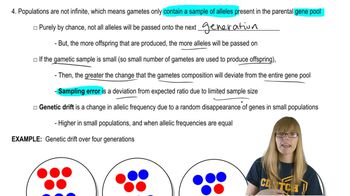Table of contents
- 1. Introduction to Genetics51m
- 2. Mendel's Laws of Inheritance3h 37m
- 3. Extensions to Mendelian Inheritance2h 41m
- 4. Genetic Mapping and Linkage2h 28m
- 5. Genetics of Bacteria and Viruses1h 21m
- 6. Chromosomal Variation1h 48m
- 7. DNA and Chromosome Structure56m
- 8. DNA Replication1h 10m
- 9. Mitosis and Meiosis1h 34m
- 10. Transcription1h 0m
- 11. Translation58m
- 12. Gene Regulation in Prokaryotes1h 19m
- 13. Gene Regulation in Eukaryotes44m
- 14. Genetic Control of Development44m
- 15. Genomes and Genomics1h 50m
- 16. Transposable Elements47m
- 17. Mutation, Repair, and Recombination1h 6m
- 18. Molecular Genetic Tools19m
- 19. Cancer Genetics29m
- 20. Quantitative Genetics1h 26m
- 21. Population Genetics50m
- 22. Evolutionary Genetics29m
21. Population Genetics
Allelic Frequency Changes
Problem 13b
Textbook Question
Two populations of deer, one of them large and living in a mainland forest and the other small and inhabiting a forest on an island, regularly exchange members that migrate across a land bridge that connects the island to the mainland. An earthquake destroys the bridge between the island and the mainland, making migration impossible for the deer. What do you expect will happen to allele frequencies in the two populations over the following 10 generations?
 Verified step by step guidance
Verified step by step guidance1
Understand the concept of gene flow: Gene flow refers to the transfer of alleles or genes from one population to another. In this scenario, the land bridge allowed gene flow between the mainland and island deer populations, maintaining genetic similarity between them.
Consider the impact of isolation: With the destruction of the land bridge, the two populations are now reproductively isolated. This means there will no longer be gene flow between the island and mainland populations, leading to independent evolution of allele frequencies in each population.
Analyze genetic drift in the island population: The island population is smaller, which makes it more susceptible to genetic drift. Genetic drift is the random fluctuation of allele frequencies due to chance events, and it can lead to significant changes in allele frequencies over generations in small populations.
Evaluate the role of natural selection: Natural selection may act differently on the two populations due to differences in environmental pressures on the island and mainland. Over time, this could lead to divergence in allele frequencies as each population adapts to its specific environment.
Predict long-term outcomes: Over 10 generations, the lack of gene flow, combined with genetic drift and natural selection, is likely to result in genetic divergence between the two populations. The island population may experience more pronounced changes due to its smaller size and potential for stronger environmental pressures.
 Verified video answer for a similar problem:
Verified video answer for a similar problem:This video solution was recommended by our tutors as helpful for the problem above
Video duration:
1mPlay a video:
Was this helpful?
Key Concepts
Here are the essential concepts you must grasp in order to answer the question correctly.
Genetic Drift
Genetic drift refers to the random fluctuations in allele frequencies within a population, particularly in small populations. When the land bridge is destroyed, the island population becomes isolated, leading to genetic drift as it can no longer exchange alleles with the mainland population. Over generations, this can result in significant changes in allele frequencies due to chance events, especially in the smaller island population.
Recommended video:
Guided course

Genetic Drift
Gene Flow
Gene flow is the transfer of genetic material between populations through migration and interbreeding. In this scenario, the destruction of the land bridge halts gene flow between the mainland and island deer populations. This isolation can lead to divergent evolution, as each population adapts to its specific environment without the influence of the other, potentially resulting in distinct genetic traits over time.
Recommended video:
Guided course

Mapping Genes
Natural Selection
Natural selection is the process by which certain traits become more or less common in a population based on their advantages or disadvantages in a given environment. With the populations now isolated, different selective pressures may act on the mainland and island deer, leading to adaptations that enhance survival and reproduction in their respective habitats. Over generations, this can further differentiate the allele frequencies between the two populations.
Recommended video:
Guided course

Natural Selection
Related Videos
Related Practice
Textbook Question
Catastrophic events such as loss of habitat, famine, or overhunting can push species to the brink of extinction and result in a genetic bottleneck. What happens to allele frequencies in a species that experiences a near-extinction event, and what is expected to happen to allele frequencies if the species recovers from near extinction?
369
views


